Impress your Dining Friends and the Head Sushi Chef with your practice of Proper Sushi Bar Etiquette!
Think your Sushi bar etiquette need a little brushing up? Nervous about your Sushi Bar knowledge? Not sure what you should or should not do when you get there?
No Worries. Keep reading and you'll be a pro in no time!
But before we talk about the real nuts and bolts of sushi etiquette, a few words for the nervous nelli sushi first timers and where you should go for your first sushi dining experience.
First off, Don't Stress
There seems to be a little apprehension for some people planning their first trip to a sushi bar. You may be worried that you won't have a clue and might embarrass yourself.
Well, believe me, its really not as bad as you think. Remember, Sushi Chefs are use to having newbies visit their Sushi Bar. They don't expect everybody to know perfect sushi bar etiquette. And also remember that EVERYBODY has a first time. And they know this too.
If it makes you feel better, go with a friend who has been before. Someone who hopefully already knows at least a little sushi bar etiquette. There's a feeling of security and comfort that comes in experiencing things for the first time with others who are in the same boat as you...
But, if you don't have an experienced friend to go with you, don't worry. A good Sushi Chef is normally experienced at putting his customers at ease as well as providing excellent customer service.
So, relax and have good time! He's there for you!
So, which Sushi Bar should I go to?
d
(The answer to that will partly depend on whether you want a real Japanese Sushi Chef or not...)
My mother (who is 80 years old and Japanese) brought this to my attention just the other day. We have lived in the U.S. for over 30 years now.
And she was complaining about how most of the Sushi Chefs here in the U.S. are not real Japanese Sushi Chefs trained in Japan. You see, for one, she likes to banter and carry on conversations with the Japanese Sushi Chefs. And secondly, if the Sushi Chef is not Japanese, she says the sushi rice usually ends up being sub-par...and honestly, if the sushi rice is not good, then the sushi can't be good. Just ONE reason why it may take up to 10 years of training before one can become a full blown Sushi Chef in Japan...
Now, that's not to say the sushi rice won't be good if the sushi chef is not Japanese. You will have to be the judge. You will just have to put your investigative skills to work and find out for yourself.
Now, if the Sushi Rice is good, you might not care if your Sushi Chef is Japanese. And in that case if you don't care, then that is fine.
But if you are wanting a true, hardcore, trained in Japan for years authentic Japanese Sushi Chef experience, you'll have to do some research before picking your sushi bar/restaurant. The following 3 guides are listed in order of most important to least important.
1. Give the restaurant/sushi bar a call and just ask if their Sushi Chef is Japanese (and trained in Japan if you want to be extra confident before you go). Now, most Sushi Bars will have several Sushi Chef's; if the Head Sushi Chef is Japanese you've struck gold. Those under him won't matter as much as he will probably insure that they are being trained and learning properly.
2. Another thing you can do is try to find a sushi bar where the local Japanese go to eat. That is usually always a very good quality indicator. The Sushi Chef may not be Japanese, but if you walk into a place and you see quite a few Japanese inside, you are probably good to go. He was probably trained well. Japanese are usually picky people.
3. And as a last resort, if you can't verify either of the above, try checking online for reviews. This will give you a good general gauge as to whether a place is any good or not.
OK. Now that you've picked a Sushi Bar to checkout, Let's pay the place a visit!
Get the Best Seat in the House
Find the Itamae
If you are going to a Sushi Bar or Sushi Restaurant, then the best seats in the house are...you guessed it...at the Sushi Bar!
If there are several sushi chefs behind the refrigerated glass counter you want to try to find a seat nearest the one who is the Head Sushi Chef or Itamae. He will normally be servicing up to around the 6 people in his vicinity.
Normally, the Itamae will be the one stategically located in the most prominent place behind the refrigerated counter and probably the spot closest to the door. He will also be the one barking orders to the others; he will never be the one making runs to the back to get things. That one will probably be the wakitta which means "side cutting board" but to you is basically an assistant.
With your seat near the Itamae secured, let's tackle what's next.
Survey your Surroundings and get to know your Place Settings
So here you are...You've been seated at the Sushi Bar. You will find, if not already, then very soon that several items will be provided for you. They should be:
- Disposable Chopsticks. Open the paper package holding the chopsticks. Fold the paper package to use as a chopstick holder (if a ceramic chopstick holder has not been provided) and place the paper holder in front of you. Break the chopsticks apart and place them together, never separate, with the eating end of the tips pointing to the left and resting on the chopstick holder. Now, there is a sushi bar etiquette debate going on about the use of disposable chopsticks. This relates to the act of removing the splinters from the very cheap chopsticks that usually have visual splinters on them when you break them apart. My mother always rubs the two chopsticks together on the eating ends to smooth and remove any "splinters" if they are the cheap kind. I always do this too. Some say it is improper. I say that those who decide not to can pick splinters out of their lips, but as for me, I won't be :-) But don't do this "rubbing" trick on the good, smooth disposable bamboo chopsticks as it will be an insult.
- Small Saucer and a container of Soy Sauce. Pour a small amount of soy sauce into the small saucer. About a tablespoon or so should do. If wasabi has already been provided, again there is a sushi bar etiquette debate as to whether you should add any to your soy sauce or not. The "experts" say to never add it. I disagree. To a point. If you want to follow the rules that they put in all the books and post online and the one that 90% of the real Japanese DON'T follow when they eat sushi, then DON'T add wasabi to your soy sauce. My mother and I have had deep discussions on this topic. She always adds it. I always add it. All of her Japanese friends add it. Her brother, who is a very, very successful business man in Japan and who always takes his customers to the finest sushi restaurants in Osaka, ALWAYS adds wasabi to his soy sauce. He puts more in his soy sauce than my mother does. So there you have it. Go by the "rules"...or do what most real Japanese people do (I told you I was a rebel...) I almost forgot about this, but I do have one more thing to add. If you happen to be lucky enough to get the "real" freshly ground wasabi root, I would probably not add that to my soy sauce, but would rather just take my chopsticks and put a little swipe on my nigiri or maki sushi before dipping that in pure soy sauce if I wanted the extra wasabi flavor. Reason is, freshly ground wasabi root would be a real treat since you can hardly get it in a sushi restaurant so I would not want to dilute the flavor of that. So in my mind, there is a difference in what I would do when I get real ground wasabi root versus the fake wasabi that we always tend to get.
- Oshibori. This is a little towel that is provided for you to clean your hands during your meal. It may be hot or cold depending on the season. Always clean your hands with the towel before you start eating and fold or roll it back up and put it back on the dish it came on. Use it as necessary during your meal, in between pieces of sushi, or whatever to keep your hands clean.
Chopstick Sushi Bar Etiquette
- Always place your chopsticks together, eating end resting on the chopstick holder or folded paper that came with the disposable chopsticks
- When your chopsticks are on the chopstick rest, point the tip (eating end) to the left
- Never stick your chopsticks upright in your rice
- Don't spear your food with a chopstick
- Never cross your chopsticks as this is a sign of death
- Never pass food using chopsticks to another persons chopsticks as this is bad luck. As part of a traditional funeral ceremony, relatives pass the creamated bones of the deceased with chopsticks before putting them in the burial pot
- When using chopsticks to retrieve food from a communal plate, turn them around so that you use the non-eating end to pickup the food
- In a formal situation, put disposable chopsticks back in the wrapper when you are done eating
If you want to learn more about Chopsticks in general, visit our Chopsticks page.
What to Drink
Shortly after being seated, you will be asked what you want to drink. You may be automatically be given tea (ocha) or agari when it is drunk with sushi.
There is proper sushi bar etiquette associated with the drink you choose to have with your sushi. Keep reading to get tips on that.
Green Tea
If you are not given tea automatically, you can request it. Green Tea is one of the best things to drink when eating sushi as it is clean and refreshing and cleanses the palate' between pieces of sushi.
There are 3 main types of green teas. Bancha, which should steep for 2-3 minutes before drinking. Sencha which should steep for about 1 minute before serving. And Gyokuro which is an expensive green tea, generally considered not suitable for serving with Sushi. More than likely you will get Bancha or Sencha at the sushi bar.
If you want to learn a lot more about Green Tea in general, like how to pick out the best green tea or how to brew it, then visit our Green Tea page.
Beer
You can also order beer which is very common and accepted also. My mothers brother (mentioned earlier) always drink beer with his sushi. I personally like having green tea and also order a beer. I tend to like Sapporo more than Kirin (two popular Japanese beers) because to me Sapporo tastes smoother whereas Kirin tastes a little bitter. I think the smoother beer goes better with Sushi. But by all means, drink whatever you like.
Sake
Sake is not consumed as often by Japanese as the prior two when eating Sushi. One reason for this is that the Sake is made from rice and tends to conflict with the flavors of the sushi rice.
If you want to have it but don't want it to conflict with your meal, you can drink it early in your meal or right before. Usually it is an accepted custom to drink sake with any sashimi you order (like an appetizer) prior to ordering your sushi, because technically sashimi is not sushi.
Sake comes in 3 grades. Tokkyu, which is the premium class and the most expensive. Ikkya, which is first class and still excellent. And then there is Kikyu, which is considered second class but still a perfectly drinkable table wine. This grading system doesn't reflect anything about flavor which can range from dry to sweet.
Despite common belief, Sake is normally served at room temperature or slightly chilled. The practice of serving Sake hot dates to the post-war period when rice was scarce and Sake had to be made by adding pure alcohol and glucose so it was heated to mask its inferior smell and flavor.
With that said, Robust and full-bodied Sake's like Honjozo and Junmai are best served warm---around body temperature (95-98 degrees). Futsu-shu should also be warmed.
Premium Sake's (anything with "Ginjo" in the name) should be served chilled (around 50 degrees).
To learn a lot more about Sake, visit our Sake page.
Drinking Sushi Bar Etiquette
Yes, believe it or not, there are a few rules on how you consume your beverages also.
- Never pour your own drink. It is considered impolite.
- Lift your glass or cup for your companion to fill and then fill your companions cup.
What and How to Order your Sushi
At the Sushi bar, you usually will be provided with some type of menu in which to order from, or you can order by selecting items from the refrigerated glass case in front of you.
Say"Omakase" - and Leave your Order up to your Sushi Chef
It is common and accepted sushi bar etiquette to ask the sushi chef for his recommendation as he knows what is fresh because he probably picked it out himself that day. If you want to leave it entirely up to your Chef, then say "Omakase" which means "chef's choice".
You will be treated to the best sushi in the restaurant that day. Be sure however, to let him know if there is something that you do not like so he will omit it from his choices for you.
Also know that this option can be pricey as you will probably be getting the freshest and most expensive pieces.
If cost is an issue for you, generally you should avoid this option and rather opt for a standard combination order from the menu as these tend to be cheaper.
And cheaper yet, if you want to split hairs is to order only "Makizushi" or "Maki Rolls" as they are more filling because they contain more rice and less meat than something like "Nigiri" or hand formed sushi which have a slice of meat on top of them.
If this is your first time, and you are apprehensive about what to try...
If you are new to sushi and want to "ease" into it slowly, try eating Maki rolls on your first outing. Then you won't be forced to eat a huge slab of raw fish right out of the chute as you would be if you ordered sashimi or some kind of Nigirizushi.
And if you are really apprehensive, order something like a california roll, which doesn't have any raw fish in it. Normally only crab is the most exotic meat used for that.
For your first true "raw meat" experience, I always start people out on Tuna or "Maguro". It is a very mild, sweet tasting meat. It is a great one to start with. And don't think smells like canned tuna; fresh, raw sashimi grade tuna has no smell. If it does, you need to walk out of that sushi bar...literally.
I have seen some people say that they did not like sushi because it did not taste good. When I asked them what they had, it turned out that they tried some weird or exotic kind of meat that quite frankly tasted like crap to me too.
So on your first outing, if you are a little apprehensive, play it safe and follow the advice above so you will at least find out that sushi is good.
Then start experimenting.
When your Sushi Chef says NOT to try something...you might just want to listen...
This reminds me of a story. I had a couple of co-worker american friends that I had introduced to sushi back in the 1990's. And honestly, I thought these two ladies were the last two people on earth who I thought would like sushi. They were actually southern country girls. I'm talking barbeque, cole slaw, pinto beans and cornbread kind of girls. But low and behold...they absolutely loved it...
They loved it so much they became obsessed with it. It was so cool. Anyway, they took a trip together and decided to try what they heard was one of the best Sushi bars in San Francisco. Now these girls played golf and loved to drink beer so they made a night out of the Sushi Bar and decided to try everything in the refrigerated counter washed down with their favorite alcoholic beverage.
They said they had a Sushi Chef that was a riot. Kept them in stitches all night long. (I think they bonded with him :-)
Toward the end of the night they noticed that there was one item that the Sushi Chef had not prepared for them so they pointed at it and said, "Hey, what is that?"
And He said, "Sea Urchin".
In response they said, "Well, we noticed that you hadn't prepared that for us...what does it taste like?".
And with a slow smile the Sushi Chef responded, "It tastes like SH*IT!".
Oh, Ok. So now it was ON (you had to know these girls; saying it tasted like SH*T was like a challenge to them...) They told him to make it for them and he couldn't talk them out of it.
Cara, who was one of the ladies, said that it actually did taste like "SH*T". The only way she could explain the taste was that it tasted like a "furry ashtray".
Whatever the heck furry ashtray tastes like...
Moral? Listen to your Sushi Chef...a good one will tell you even when something tastes like "SH*T". :-)
Moving on...
Eating your Sushi
Traditionally, Sashimi comes first
Normally, Sashimi is something that you will order first, like an appetizer. Sashimi is normally served with shredded daikon (japanese white radish).
Following proper sushi bar etiquette, either mix a little wasabi in your soy sauce to dip your sashimi (see section below on Eating Sushi Etiquette for more on wasabi) in or you may also get some ponzu sauce (a citrus based sauce made by simmering mirin, rice vinegar, katsuobushi flakes (from tuna) and kombu (seaweed used for dashi)) to dip it in.
Take your chopsticks (always use chopsticks with sashimi), pick up a piece of sashimi, dip it in the sauce of your choice, lay it back on the daikon and then pick up the sashimi again but this time pick up some daikon with it.
Put it all in your mouth at one time. When you have swallowed the sashimi, eat a piece of ginger (to cleanse your pallet) and follow that with a sip of green tea or beer. (see section Eating Sushi Etiquette below for more on ginger).
Lather, rinse and repeat till your are done.
When you are done, lay your chopsticks on your chopstick rest, or your folded paper that held your disposable chopsticks. NEVER on the table and never point them to the right (chopsticks pointed to the right are bad luck).
Eating your Nigiri or Maki Sushi
For most, this will be the main part of your meal. If you ordered Nigiri it should look like the left picture above. If you ordered any kind of Maki Sushi it should look like the picture on the right above.
The Nigiri sushi can be eaten with chopsticks or by hand. It is probably easier to eat by hand, and originally was sold on the street and meant to be eaten by hand.
The said "proper" technique is to pick the Nigiri up, so that the meat is on the bottom, and dip the corner in the soy sauce dish (meat only) and put the whole thing in your mouth at one time with it still upside down so that the meat touches your tongue first. This is so you taste all of the flavor of the meat first and sushi rice second.
In Japan this one mouthful technique is quite possible as the Nigiri is made smaller than it usually is here in the United States.
If you can't put it all in your mouth at one time, then eat half of it, keep the other half in your hand (don't put it back down on the plate) and then eat the remaining half after you swallow the first half.
Not putting your half eaten sushi back down is done because it is an insult to put food back on the plate after you have made a trip to your mouth with it...And it kind of means to the Chef that it must not taste very good if you want to put it back down on the plate...to him it totally has nothing to do with the fact that you would choke to death if you could actually get all of it in your mouth all at one time...
You'll just have to roll with it...
Eating Maki Rolls is similar to eating Nigiri. You can also eat Maki rolls by hand or with chopsticks. Again dip the corner of your Maki roll piece in the soy sauce (if desired) and pop the whole thing in your mouth at one time. Chew, swallow and then get a piece of ginger to cleanse the pallet and finish off with a nice sip of tea or beer.
Congratulations! You are now an expert!
Sushi Eating Etiquette
- The experts say to NOT mix wasabi with your soy sauce. I disagree. If you want to know why, I have already ranted and raved about it multiple times. Here and here.
- The experts also say NOT to eat ginger with your Sushi but rather after you eat your sushi to "cleanse" your pallet. W-H-A-T-E-V-E-R... What is this? Wine?? Again. I disagree. I know what real Japanese people usually do with their ginger. When I asked my 80 year old Japanese mother about it, she said, "Well, I eat my ginger with my Sushi. Who said that? They must not be Japanese". She did qualify her statement by saying, "You just eat the ginger when you want to...it's your choice". Look. I'm not telling you not to follow tradition. Not at all. I think its great if you want to follow tradition. I just want people to know where the truth bends, and what real Japanese people do in relation to what "tradition dictates" just so you know and you won't have to feel guilty if you "break the rules". Because you know what? It's ok. 80 million Japanese people just broke that rule with you too. Tell that to your "Sushi Expert" buddy the next time he corrects you. :-) Bull Ya!
- Eat each sushi piece all at one time if possible, and never put a half eaten piece back on your plate. It's an insult. Hold it till you can eat the other half if you can't get it all in your mouth with one bite.
- This is splitting hairs, but try not to leave any rice behind in your dish when you are done eating it is considered bad manners. The reason is, is that rice is held in such high regard in Japan because it has been the main food for centuries.
- It is acceptable to slurp hot tea and soup as this is a sign of enjoyment and to blow over it to help cool it.
- When you are giving or receiving food on a bowl or plate, it is polite to use both hands to accept or give the plate to another.
- Eating sushi with fingers is totally acceptable, except when eating sashimi. Always pick up sashimi with chopsticks.
Like this Page?
|
|
Follow me on Pinterest

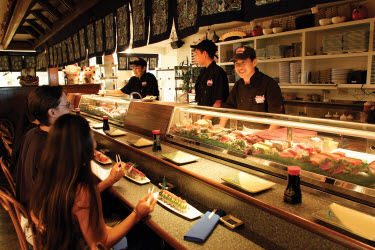

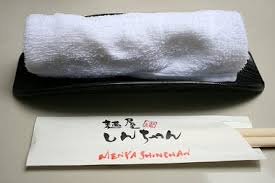

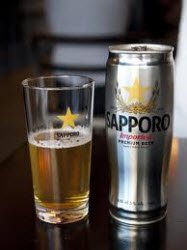
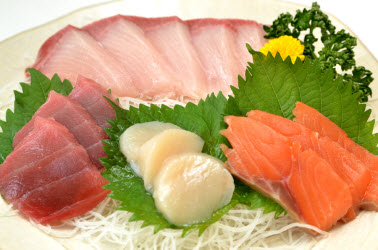
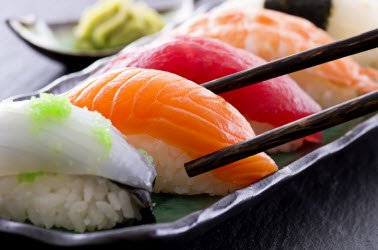
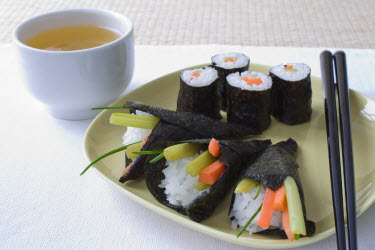





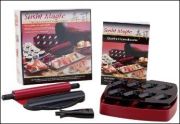

New! Comments
Have your say about what you just read! Leave me a comment in the box below.